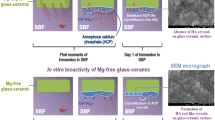Abstract
Glasses having a chemical composition based on combeite [Na2Ca2Si3O9]–fluoroapatite [Ca5(PO4)3F] and forsterite [Mg2SiO4] system were crystallized through controlled heat-treatment. Two forms of sodium calcium silicate e.g. combeite Na2Ca2Si3O9 and pectolite Na2CaSi3O8, were formed together with diopside (CaMgSi2O6) and monticellite (CaMgSiO4) in addition to fluoroapatite (Ca5(PO4)3F) phases by thermal treatment of the glasses. Selected glass–ceramics were exposed to a simulated body fluid solution (SBF) which is close to human plasma for 3 weeks. Energy dispersive X-ray analysis (EDX) and inductive coupled plasma (ICP) analysis confirmed the formation of an apatite layer which indicate bioactivity in the all crystallized sample. A decreasing of surface bioactivity with increasing Mg2SiO4/Na2Ca2Si3O9 replacement was observed as indicated by the decrease in the amount of apatite layer on the surface of the crystallized specimens. The Vicker’s microhardness of the studied glass–ceramic materials are between 5,047 and 6,781 MPa.










Similar content being viewed by others
References
Pisciella P, Pelino M. Thermal expansion investigation of iron rich glass–ceramic. J Eur Ceram Soc. 2008;28:3021–6.
Peitl O, Zanotto ED, Hench LL. Highly bioactive P2O5–Na2O–CaO–SiO2 glass–ceramics. J Non-Cryst Solids. 2001;292:115–26.
Kim H, Miyaji F, Kokubo T. Bioactivity of Na2O–CaO–SiO2 glasses. J Am Ceram Soc. 1995;78:2405–11.
Hench LL. Bioceramics. J Am Ceram Soc. 1998;81:1705–28.
Cao W, Hench LL. Bioactive materials. Ceram Int. 1996;22:493–507.
Arstila H, Vedel E, Hupa L, Hupa M. Factors affecting crystallization of bioactive glasses. J Eur Ceram Soc. 2007;27:1543.
Clupper DC, Mecholsky JJ Jr, Latorre GP, Greenspan DC. Sintering temperature effects on the in vitro bioactive response of tape cast and sintered bioactive glass–ceramic in Tris buffer. J Biomed Mater Res. 2001;57:532–40.
Salman SM, Salama SN, Darwish H, Abo-Mosallam HA. In vitro bioactivity of glass–ceramics of the CaMgSi2O6–CaSiO3–Ca5(PO4)3F–Na2SiO3 system with TiO2 or ZnO additives. Ceram Int. 2009;35:1083–93.
Clupper DC, Hench LL, Mecholsky JJ. Strength and toughness of tape cast bioactive glass 45S5 following heat-treatment. J Eur Ceram Soc. 2004;24:2929–34.
Hench LL, Ethridge EC. Biomaterials: an interfacial approach. New York: Academic Press, Inc.; 1982.
Kokubo T, Ito S, Shigematsu M, Sakka S. Mechanical properties of a new type of apatite-containing glass–ceramic for prosthetic application. J Mater Sci Eng. 1985;20:2001–4.
Salinas AJ, Roman J, Vallet-Regi M, Oliveira JM, Correia RN, Fernandes MH. In vitro bioactivity of glass and glass ceramics of the 3CaO·P2O5–CaO·SiO2–CaO·MgO·2SiO2 system. Biomaterials. 2000;21:251–7.
Salama SN, Darwish H, Abo-Mosallam HA. HA forming ability of some glass–ceramics of the CaMgSi2O6–Ca5(PO4)3F–CaAl2SiO6 system. Ceram Int. 2006;32:357–64.
Dietzel A. Z Elektrochem. 1942;48:9–23.
Bovo N. Structure—properties relationships in bioactive glasses for PAA—based polyalkenoate cements. Ph.D., Thesis. U.K.: Imperial College London; 2007.
Li P, Yang Q, Zhang F. The effect of residual glassy phase in a bioactive glass–ceramic on the formation of its surface apatite layer in vitro. J Mater Sci: Mater Med. 1992;3:452–6.
Deer WA, Howie RA, Zussman J. An introduction to the rock-forming minerals. Third ELBS impression. Hong Kong: Common Wealth, Printing Press Ltd.; 1992.
Nonami T, Tsutsumi S. Study of diopside ceramics for biomaterials. J Mater Sci: Mater Med. 1999;10:475–7.
Ricker RW, Osborn EF. Additional phase-equilibrium data for the system CaO–MgO–SiO2. J Am Ceram Soc. 1954;37:133–9.
Roy S, Basu B. In vitro dissolution behavior of SiO2–MgO–Al2O3–K2O–B2O3–F glass–ceramic system. J Mater Sci: Mater Med. 2008;19:3123–33.
Al-Haidary J, Al-Haidari M, Qrunfuleh S. Effect of yttria addition on mechanical, physical and biological properties of bioactive MgO–CaO–SiO2–P2O5–CaF2 glass ceramic. Biomed Mater. 2008;3:015005 (5pp).
Hench LL, West J. Biological applications of bioactive glasses. Life Chem Rep. 1996;13:187.
Paul A. Chemistry of glasses. London: Chapman & Hall; 1982.
Oliveira JM, Correia RN, Fernandes MH. Effects of Si speciation on the in vitro bioactivity of glasses. Biomaterials. 2002;23:371–9.
Oliveira JM, Correia RN, Fernandes MH. Surface modification of a glass and a glass–ceramic of the MgO–3CaO·P2O5–SiO2 system in a simulated body fluid. Biomaterials. 1995;16:849–54.
Chen QZ, Thompson ID, Boccaccini AR. 45S5 Bioglass®-derived glass–ceramic scaffolds for bone tissue engineering. Biomaterials. 2006;27:2414–25.
Wu C, Chang J. Degradation, bioactivity, and cytocompatibility of diopside, akermanite, and bredigite ceramics. J Biomed Mater Res B: Appl Biomater. 2007;83B:153–60.
Vallet-Regi V, Salinas AJ, Roman J, Gil M. Effect of magnesium content on the in vitro bioactivity of CaO–MgO–SiO2–P2O5 sol–gel glasses. J Mater Chem. 1999;9:515–8.
Höland W, Beall GH. Glass–ceramic technology. Westerville, OH: Am. Ceram. Soc., Inc.; 2002.
Sevim I, Kulekci M. Abrasive wear behavior of bioactive glass–ceramics containing apatite. Bull Mater Sci. 2006;29:243–9.
Torres FJ, Alarcon J. Mechanism of crystallization of pyroxene based glass–ceramic glazes. J Non-Cryst Solids. 2004;347:45–51.
Park YJ, Moon SO, Heo J. Crystalline phase control of glass–ceramics obtained from sewage sludge fly ash. Ceram Int. 2003;29:223–7.
Author information
Authors and Affiliations
Corresponding author
Rights and permissions
About this article
Cite this article
Abo-Mosallam, H.A., Salama, S.N. & Salman, S.M. Formulation and characterization of glass–ceramics based on Na2Ca2Si3O9–Ca5(PO4)3F–Mg2SiO4-system in relation to their biological activity. J Mater Sci: Mater Med 20, 2385–2394 (2009). https://doi.org/10.1007/s10856-009-3811-4
Received:
Accepted:
Published:
Issue Date:
DOI: https://doi.org/10.1007/s10856-009-3811-4



